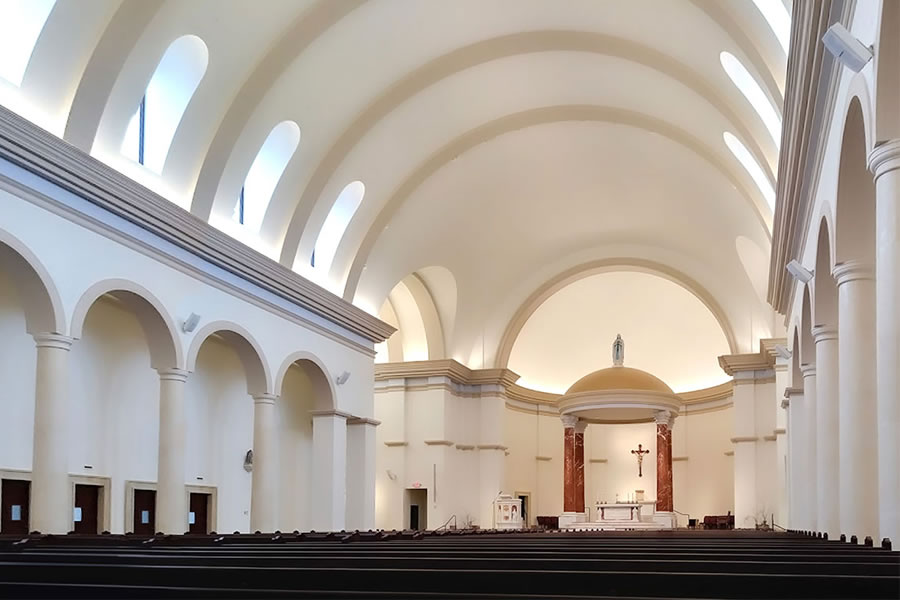
Reflecting Heaven Part 2: The Church as Heaven on Earth
05-12-2021Reflecting HeavenFr. Don Kline, V.F.As set out in last week’s article, the upcoming renovation at St. Bernadette is not a renovation of the entire building, but only the worship space itself – that is, the sanctuary and the nave. Next week we’ll look at exactly what the sanctuary and the nave are, but first let’s look at why they are the focus of this project.
At the turn of the millennium, the U.S. Conference of Catholic Bishops published Built of Living Stones: Art, Architecture, and Worship (BLS), giving guidance and direction to designers and builders of Catholic churches. BLS draws heavily on previous Church documents, including those of the Vatican Council II.
Even before BLS treats the brick-and-mortar aspect of churches, it emphasizes, as the title suggests, that the true Catholic Church (capital “C”), the Mystical Body of Christ, is made up of the faithful themselves – the “living stones” referenced by St. Peter himself (1Pt 2:5), the Rock (Petrus) on whom Christ built his Church. But the church building (small “c”), is also “of critical importance,” say the bishops: “That building is both the house of God on earth (domus Dei) and a house fit for the prayers of the saints (domus ecclesiae). Such a house of prayer must be expressive of the presence of God and suited for the celebration of the sacrifice of Christ, as well as reflective of the community that celebrates there.” (BLS §16)
Last week’s column referred to this “vertical” (domus Dei) and “horizontal” (domus ecclesiae) nature of worship and liturgy, and the Catholic Catechism drives this point home. “These visible churches are not simply gathering places but signify and make visible the Church living in this place, the dwelling of God with men reconciled and united in Christ.” (CCC §1180)
For this reason, well-designed Catholic churches accommodate the community needs of the “living stones” who come to worship there, but also direct our hearts and minds to a mystical reality, and therefore look, smell, and feel somehow both in this world, yet not of this world.
For those of you with philosophy 101 in your background, this principle of the church as a reflection of heavenly reality may bring to mind Plato’s idea of Forms. Plato taught that all physical forms on earth are just approximations of mystical “Forms,” un-seeable realities that we should strive to know. Plato’s philosophy had a great impact on Church Fathers such as St. Augustine.
In a similar way, the Catholic Church has long taught that the church building itself should be a form of the true Form of Heaven. When we walk into the church building, or even when we see it from outside, we should be filled with a longing for our true Heavenly home, and a sense of awe in the presence of God. It should have a certain “Church-ness,” or even “Heaven-ness” about it.
How can we know what Heaven looks and feels like? Well, perhaps we can’t exactly, but Scripture does give us some hints.
Each year at the great Easter Vigil, we hear a reading in which the Prophet Isaiah speaks of God’s plans for the new Jerusalem: “I lay your pavements in carnelians, and your foundations in sapphires; I will make your battlements of rubies, your gates of carbuncles, and all your walls of precious stones.” (Isaiah 54:11-12)
The book of Revelation (Rev 21:10-27) gives a similar description of the walls of the Kingdom being decorated with gold, jasper, sapphire, emeralds, carnelians, beryls, amethysts, pearls, and the like. These descriptions are the source of the idea of stained glass in churches, portraits in light and color of the Kingdom of Heaven, sometimes depicted simply in shapes (abstract stained glass), and sometimes depicting the Saints who await us in Heaven (as in our new stained glass), with their portraits made up of “jewels,” as it were.
Heaven has also been described as the true Form of the Garden of Eden, lush in vegetation, flowers, and bearing great fruit. Where, as we’ve just heard in the Book of Isaiah in Advent: “The wolf shall be a guest of the lamb, and the leopard shall lie down with the kid; the calf and the young lion shall browse together, with a little child to guide them.” (Isaiah 11:6)
Thus the great tradition in church art and architecture of decorating with plants and flowers – both real and painted and carved in wood and stone. Those flowers are not just there to look and smell pretty; they’re to rekindle our longing for Heaven, where the fruit and flowers will be beyond our imagining.
On April 4, 1999 (Easter Sunday), St. Pope John Paul II published an open letter to artists, exhorting them to use their creative gifts in the building up of the Church and to further the Kingdom of God. His instruction provides an apt summary to this week’s column:
“Art must make perceptible, and as far as possible attractive, the world of the spirit, of the invisible, of God. It must therefore translate into meaningful terms that which is in itself ineffable. Art has a unique capacity to take one or other facet of the message and translate it into colors, shapes and sounds which nourish the intuition of those who look or listen.” (Letter to Artists, §12)
This is what we strive for in the upcoming renovation.
Next week: the sanctuary and the nave.
BACK TO LIST